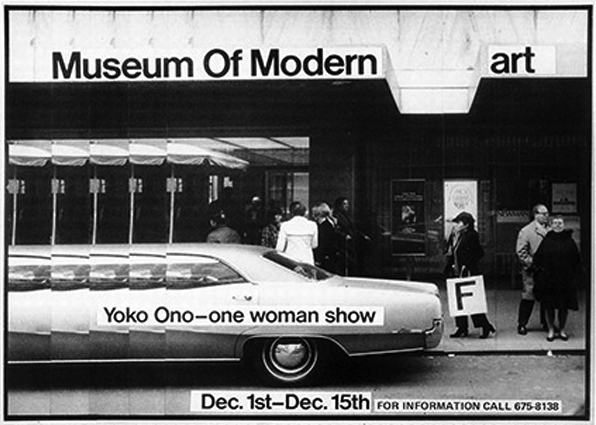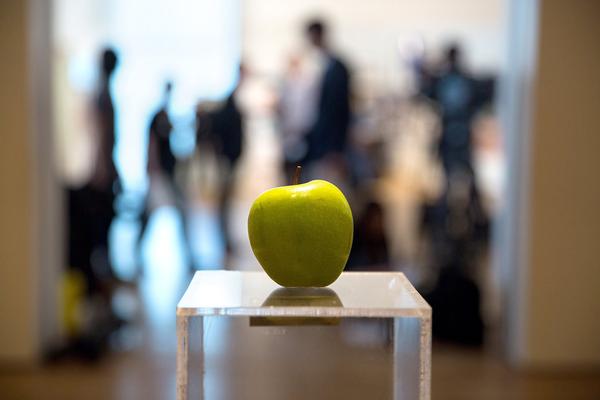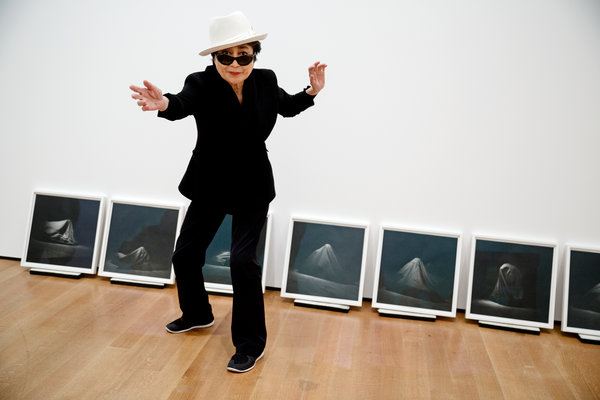
In 1971, Yoko Ono placed ads in the Village Voice and The New York Times announcing The Museum of Modern [F]art, her one-woman show at MoMA. The 100-page exhibition catalogue included an image of Yoko Ono in MoMA’s sculpture garden with a jar of flies, which were to be released into the city and then photographed as they buzzed across New York.
When visitors arrived for the exhibition, from December 1 to 15, 1971, a sign at the entrance invited them to track the flies, which had already dispersed, and a handwritten note on the museum’s ticket counter advised, “This Is Not Here.” In fact, it wasn’t. Notwithstanding newspaper ads, the catalogue, and MoMA visitors who gave their opinions about the show, the exhibition was conceptual and hadn’t happened at all.

Today, Yoko Ono: One Woman Show, 1960-1971 actually opened at MoMA. For real. It’s official. There are 125 objects in the museum’s sixth-floor galleries. If you’re mad at Klaus Biesenbach and MoMA about Björk or Marina Abramović, stop it. Yoko Ono will be very popular with visitors, but it’s art world approved with solid content. Ono’s work has early connections to Fluxus, and her career beyond that has included experimental film, instruction-based text works, participatory installations, and performance art. She’s also really wonderful on Twitter.

Among the films presented, Cut Piece is requisite in contemporary art history courses. In the 1964 performance (MoMA is showing the film from a 1965 performance), Ono asks visitors to cut away pieces of her clothing while she sits still on a stage.
Also from 1964, the typewritten/handwritten contents of Grapefruit are displayed, page-by-page, on a very long wall. The book of instructions includes entries such as “Listen to the sound of the earth turning,” and “Imagine the clouds dripping. Dig a hole in your garden to put them in.” Ono’s additional instructions were to “Burn this book after you’ve read it,” and John Lennon added, “This is the greatest book I’ve ever burned.” The sequel, Acorn, was published in 2013.

The exhibition also includes facsimiles of original installations including Painting to be Stepped On (1960/61), Bag Piece (1964), and Apple (1966). Painting to Be Stepped On is not only a title, but also an instruction, and Bag Piece invites visitors to get into a black cloth bag while others look on. These installations are participatory and confound the “do not touch” custom of art museums. Apple is actually an apple, on a plexiglas pedestal with a brass plaque, which will be left to decompose until it is a seed again.

In a recent interview for ARTnews, Yoko Ono summed up this exhibition and explicated the significance of her conceptual work:
“There was a conceptual show,” she said, “and then there’s a reality that came from it a long time later”—referring to the current, real-life exhibition at MoMA. “And likewise,” she continued, “I think that we’re all thinking of having world peace, and I’m sure that’s going to happen, in reality. What I was doing in my work was not just showing how great I am as an artist or something. I was showing how you can deal with life. If you think about it conceptually, it can happen later.”

Yoko Ono: One Woman Show, 1960-1971 draws from MoMA’s 2008 acquisition of the Gilbert and Lila Silverman Fluxus Collection.
The exhibition continues through September 7, 2015.